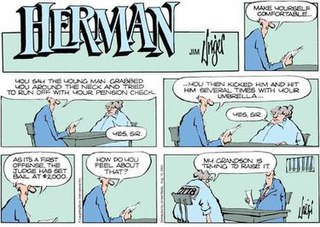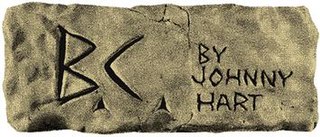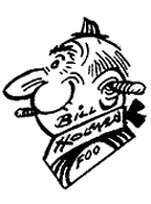Related Research Articles

A comic strip is a sequence of cartoons, arranged in interrelated panels to display brief humor or form a narrative, often serialized, with text in balloons and captions. Traditionally, throughout the 20th and into the 21st century, these have been published in newspapers and magazines, with daily horizontal strips printed in black-and-white in newspapers, while Sunday papers offered longer sequences in special color comics sections. With the advent of the internet, online comic strips began to appear as webcomics.

A cartoon is a type of visual art that is typically drawn, frequently animated, in an unrealistic or semi-realistic style. The specific meaning has evolved, but the modern usage usually refers to either: an image or series of images intended for satire, caricature, or humor; or a motion picture that relies on a sequence of illustrations for its animation. Someone who creates cartoons in the first sense is called a cartoonist, and in the second sense they are usually called an animator.

The National Cartoonists Society (NCS) is an organization of professional cartoonists in the United States. It presents the National Cartoonists Society Awards. The Society was born in 1946 when groups of cartoonists got together to entertain the troops. They enjoyed each other's company and decided to meet on a regular basis.

Milton Arthur Paul Caniff was an American cartoonist known for the Terry and the Pirates and Steve Canyon comic strips.

Herman is a comic strip written and drawn by Jim Unger. While the daily ran as a single panel with a typeset caption, it expanded every Sunday as a full multi-panel strip with balloons.

They'll Do It Every Time is a single-panel newspaper comic strip, created by Jimmy Hatlo, which had a long run over eight decades, first appearing on February 5, 1929, and continuing until February 3, 2008. The title of the strip became a popular catchphrase.

King Features Syndicate, Inc. is an American content distribution and animation studio, consumer product licensing and print syndication company owned by Hearst Communications that distributes about 150 comic strips, newspaper columns, editorial cartoons, puzzles, and games to nearly 5,000 newspapers worldwide. King Features Syndicate also produces intellectual properties, develops new content and franchises, like The Cuphead Show!, which it produced with Netflix, and licenses its classic characters and properties.

B.C. is a daily American comic strip created by cartoonist Johnny Hart. Set in prehistoric times, it features a group of cavemen and anthropomorphic animals from various geologic eras.
A daily strip is a newspaper comic strip format, appearing on weekdays, Monday through Saturday, as contrasted with a Sunday strip, which typically only appears on Sundays. They typically are smaller, 3–4 grids compared to the full page Sunday strip and are black and white.

The Lockhorns is a United States single-panel cartoon created September 9, 1968 by Bill Hoest and originally distributed by King Features Syndicate to 500 newspapers in 23 countries. The Lockhorns joined Andrews McMeel Syndication (AMS) January 1, 2024 and continues to appear in hundreds of newspapers worldwide and online through websites including AMS's GoComics! After Hoest's death in 1988 the comic panel was continued by his wife Bunny Hoest and cartoonist John Reiner. In 2017 Hoest donated the archives of more than 37,000 of her cartoons - including The Lockhorns, Howard Huge and others - to Adelphi University where she obtained a Bachelor of Arts degree and an honorary doctorate.

Grin and Bear It is a former daily comic panel created by George Lichtenstein under the pen name George Lichty. Lichty created Grin and Bear it in 1932 and it ran 83 years until 2015, making it the 10th-longest-running comic strip in American history. Frequent subjects included computers, excessive capitalism and Soviet bureaucracy. Situations in his cartoons often took place in the offices of commissars, or the showrooms of "Belchfire" dealers with enormous cars in the background. His series "Is Party Line, Comrade!" skewered Soviet bureaucrats, always wearing a five-pointed star medal with the label "Hero".

Henry Boltinoff was an American cartoonist who worked for both comic strips and comic books. He was a prolific cartoonist and drew many of the humor and filler strips that appeared in National Periodical comics from the 1940s through the 1960s.
Glenn McCoy is a conservative American cartoonist, whose work includes the comic strip The Duplex and the daily panel he does with his brother Gary entitled The Flying McCoys. McCoy previously produced editorial cartoons until May 2018, when he refocused his career on animations after being discharged from his job of 22 years at the Belleville News-Democrat. All three cartoon features are syndicated by Andrews McMeel Syndication.
A comic strip syndicate functions as an agent for cartoonists and comic strip creators, placing the cartoons and strips in as many newspapers as possible on behalf of the artist. A syndicate can annually receive thousands of submissions, from which only two or three might be selected for representation. In some cases, the work will be owned by the syndicate as opposed to the creator. The Guinness World Record for the world's most syndicated strip belongs to Jim Davis' Garfield, which at that point (2002) appeared in 2,570 newspapers, with 263 million readers worldwide.
Charles Boyce, is an American cartoonist known for his syndicated comic panel Compu-toon. Boyce is also known for creating the KeyPad Kid, a cartoon character used in public affairs awareness programs for training within the telecommunication industry.
Margaret Shulock was an American cartoonist who worked as a writer-artist on several features.

Bill Holman was an American cartoonist who drew the classic comic strip Smokey Stover from 1935 until he retired in 1973. Distributed through the Chicago Tribune syndicate, it had the longest run of any strip in the screwball genre. Holman signed some strips with the pseudonym Scat H. He once described himself as "always inclined to humor and acting silly."

Life's Like That was a gag panel by Fred Neher which found humor in life's foibles. Spanning five decades -- from October 1, 1934 to August 20, 1977 — the panel was initially distributed by Consolidated News Features, and later by the Bell-McClure Syndicate and the United Feature Syndicate.
Quincy is an American syndicated newspaper comic strip published from July 13, 1970 to October 4, 1986, created and produced by cartoonist Ted Shearer. The series, about an African-American boy being raised by his grandmother in Harlem, was one of the earliest mainstream comic strips to star an African American in the lead role, following Dateline: Danger! (1968-1974) and Luther (1969-1986). Another predecessor, Wee Pals, features an African-American among an ensemble cast of different races and ethnicities.
The Field Newspaper Syndicate was a syndication service based in Chicago that operated independently from 1941 to 1984, for a good time under the name the Chicago Sun-Times Syndicate. The service was founded by Marshall Field III and was part of Field Enterprises. The syndicate was most well known for Steve Canyon, but also launched such popular, long-running strips as The Berrys, From 9 To 5, Rivets, and Rick O'Shay. Other features included the editorial cartoons of Bill Mauldin and Jacob Burck, and the "Ask Ann Landers" advice column.
References
- ↑ Holtz, Alan. "Jo Fischer's From 9 to 5 Archived 2017-02-16 at the Wayback Machine , Stripper's Guide (June 2007).
- ↑ "20 ORIGINAL PANEL CARTOONS COMIC ART BY JO FISCHER CHICAGO SYNDICATED ARTIST," Archived 2017-02-16 at the Wayback Machine WorthPoint. Accessed Nov. 10, 2017.
- 1 2 3 Heise, Kenan. "Jo Fischer, 'From 9 To 5' Cartoonist," Chicago Sun-Times (March 28, 1987).
- ↑ Fischer, Jo, "From 9 To 5", San Bernardino Daily Sun, San Bernardino, California, Tuesday 1 December 1953, Volume LX, Number 79, page 11.